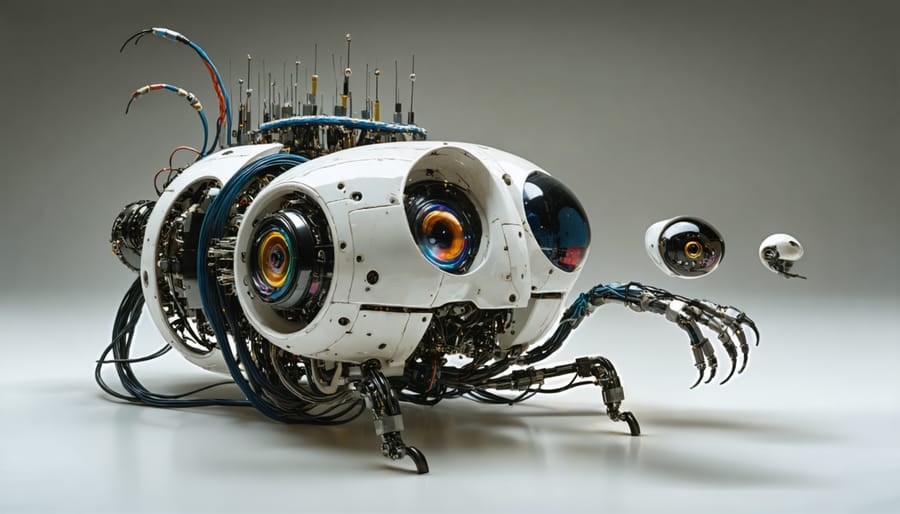Every technology you use today—from smartphone voice assistants to medical diagnostic tools—stems from the bold vision of a handful of remarkable individuals who dared to ask: “Can machines think?” These pioneers didn’t just create new gadgets; they fundamentally reimagined what was possible, transforming theoretical concepts into practical realities that now shape every aspect of modern life.
The story of artificial intelligence begins not in Silicon Valley’s gleaming offices, but in the minds of mathematicians, logicians, and dreamers working in the mid-20th century. While contemporary AI dominates headlines with ChatGPT and self-driving cars, the early AI breakthroughs that made these innovations possible remain largely unknown to the public. Understanding these foundational contributions reveals not just historical curiosities, but the intellectual DNA embedded in every algorithm running today.
Alan Turing questioned whether machines could exhibit intelligent behavior indistinguishable from humans. John McCarthy coined the term “artificial intelligence” and organized the pivotal Dartmouth Conference that launched the field. Marvin Minsky explored neural networks and computer vision. Frank Rosenblatt built the Perceptron, the ancestor of modern deep learning. These weren’t isolated geniuses working in vacuums—they formed a collaborative community, building upon each other’s insights while facing skepticism, funding challenges, and technological limitations that would have discouraged lesser minds.
Their legacy isn’t merely academic. The pattern recognition systems they conceived now detect cancer in medical scans. Their natural language processing theories enable real-time translation across languages. Their machine learning frameworks power recommendation engines that influence billions of daily decisions. By exploring their journeys—the problems they tackled, the setbacks they overcame, and the breakthroughs they achieved—we gain essential context for understanding where AI is headed next.

The Father of AI: John McCarthy and the Birth of a Field
The Dartmouth Conference: Where It All Began
In the summer of 1956, a small group of brilliant minds gathered at Dartmouth College in Hanover, New Hampshire, for a workshop that would change the course of computing history. Organized by John McCarthy, Marvin Minsky, Nathaniel Rochester, and Claude Shannon, this two-month conference had an audacious goal: to explore whether machines could simulate every aspect of human intelligence.
The proposal was nothing short of revolutionary. The organizers believed that “every aspect of learning or any other feature of intelligence can, in principle, be so precisely described that a machine can be made to simulate it.” This wasn’t just optimistic thinking—it was a bold declaration that launched artificial intelligence as a formal field of study.
What made this gathering so significant? For the first time, researchers from different disciplines—mathematics, psychology, engineering, and computer science—came together under one banner. They discussed groundbreaking concepts like neural networks, natural language processing, and machine learning. Though the conference didn’t produce immediate technical breakthroughs, it created something more valuable: a shared vision and vocabulary for the emerging field.
The term “artificial intelligence” itself was coined for this event, giving researchers a rallying point and a common identity. The Dartmouth Conference established AI as a legitimate area of scientific inquiry, attracting funding, talent, and institutional support that would fuel decades of innovation. It transformed what had been scattered theoretical musings into a coordinated research agenda that continues to shape our world today.

LISP: The Language That Powered Early AI
In 1958, John McCarthy created LISP (LISt Processing), a programming language that would dominate AI research for decades. What made LISP revolutionary? Unlike earlier languages designed for number crunching, LISP treated both data and code as lists—flexible structures that could represent complex relationships and ideas.
Imagine teaching a computer to understand family trees. In traditional languages, this required rigid, pre-defined structures. LISP allowed programmers to write code that could modify itself, learning and adapting as it processed information. This “code-as-data” philosophy made it perfect for AI experiments where researchers didn’t always know the solution path in advance.
LISP introduced features we now take for granted: automatic memory management (garbage collection), recursive functions, and interactive programming environments. Early AI breakthroughs—from expert systems diagnosing diseases to programs proving mathematical theorems—were built in LISP.
While modern AI predominantly uses Python, LISP’s influence persists. Its descendants power everything from AutoCAD to configuration management tools. More importantly, LISP established the conceptual foundation for symbolic AI, demonstrating that machines could manipulate abstract symbols and relationships—not just crunch numbers. For early AI pioneers, LISP wasn’t just a tool; it was the language of artificial thought itself.
Alan Turing: The Visionary Who Asked ‘Can Machines Think?’
The Turing Test: A Simple Game That Changed Everything
In 1950, Alan Turing posed a deceptively simple question: “Can machines think?” Rather than getting lost in philosophical debates, he proposed a practical test. Imagine you’re having a text conversation with two hidden participants—one human, one machine. If you can’t reliably tell which is which, the machine passes the test.
This “imitation game,” as Turing called it, wasn’t meant to define consciousness or intelligence perfectly. Instead, it gave researchers a concrete goal to work toward and sparked crucial conversations about what artificial intelligence actually means.
**Why It Still Matters**
The Turing Test shaped AI development for decades by establishing benchmarks for machine behavior. Today’s chatbots and virtual assistants like Siri or ChatGPT are direct descendants of this concept—systems designed to interact naturally with humans through conversation.
While modern AI researchers have moved beyond the test’s limitations (machines can excel at specialized tasks without passing it, and passing doesn’t guarantee true understanding), Turing’s fundamental insight remains powerful: intelligence can be measured through behavior rather than internal processes.
**Real-World Impact**
The test influenced everything from natural language processing to machine learning evaluation methods. When companies develop customer service bots or voice assistants, they’re essentially asking Turing’s original question: can this technology communicate convincingly enough to be useful?
This simple parlor game transformed into a foundational framework that guided seven decades of AI innovation—proving that sometimes the most profound ideas start with straightforward questions.
Beyond Code: Turing’s Philosophy of Machine Intelligence
Alan Turing didn’t just write equations—he fundamentally reimagined what machines could become. His groundbreaking 1950 paper, “Computing Machinery and Intelligence,” posed a deceptively simple question: “Can machines think?” Rather than getting lost in philosophical debates, Turing proposed a practical test that remains influential today.
The **Turing Test**, as we now call it, suggests that if a machine can convince a human they’re conversing with another person, it demonstrates intelligent behavior. Think of it as the ultimate chatbot challenge—one that modern AI assistants like ChatGPT still strive to pass convincingly.
What makes Turing’s vision remarkable is how accurately he predicted our current AI landscape. He anticipated machine learning, suggesting computers could improve through experience rather than explicit programming. He imagined neural networks before the technology existed to build them. He even foresaw AI’s ability to play chess, compose music, and engage in natural language conversations—all commonplace today.
Turing also grappled with objections that still echo in modern AI ethics discussions: Can machines truly be creative? Do they possess consciousness? His responses weren’t definitive answers but frameworks for thinking about these questions—a philosophical foundation that supports today’s debates about artificial general intelligence.
His theoretical work laid the conceptual groundwork decades before computing power caught up with his imagination, proving that sometimes the most revolutionary innovations begin not with technology, but with asking the right questions.
Marvin Minsky: Building the Brain’s Blueprint
The First Neural Network Simulator
In 1951, long before computers could fit on a desk, Marvin Minsky and his colleague Dean Edmonds built something remarkable: SNARC (Stochastic Neural Analog Reinforcement Calculator). This wasn’t software—it was a physical machine constructed from 3,000 vacuum tubes and surplus parts from a B-24 bomber.
SNARC was designed to mimic how rats learn to navigate mazes, using 40 artificial neurons connected in a network. Each “synapse” could strengthen or weaken based on success or failure, demonstrating a fundamental principle of learning. When the machine successfully found its way through a simulated maze, it reinforced the connections that led to success—much like how our brains work.
What made SNARC revolutionary wasn’t just its ability to learn, but that it made learning visible and tangible. Scientists could watch lights blink and relays click as the machine adapted its behavior. This physical demonstration proved that neural networks weren’t merely theoretical concepts—they could be built and trained to solve real problems. Though primitive by today’s standards, SNARC laid essential groundwork for understanding how machines might one day learn from experience.
The Society of Mind: Intelligence as Teamwork
Imagine your mind not as a single, unified intelligence, but as a bustling city of tiny workers—each one simple, yet together creating something remarkable. This was Marvin Minsky’s revolutionary idea in his 1986 book, *The Society of Mind*.
Minsky proposed that what we call “intelligence” isn’t one magical process. Instead, it emerges from countless specialized “agents”—mental components that each handle simple tasks. Think of it like an ant colony: individual ants follow basic rules, but together they build complex structures, find food, and defend their home.
Consider how you catch a ball. One agent tracks the ball’s movement, another calculates trajectory, while others coordinate your muscles. None of these agents is intelligent alone, but their teamwork creates the seamless action we call “catching.”
This theory transformed how we think about both human cognition and artificial intelligence. It suggested that building intelligent machines didn’t require replicating one grand “thinking” process. Instead, we could create systems where simple programs collaborate—an approach that influences modern AI architectures today, from neural networks to multi-agent systems used in robotics and autonomous vehicles.

Frank Rosenblatt and the Perceptron: The First Learning Machine
A Machine That Learns: How the Perceptron Worked
The perceptron learned through a remarkably simple process that mimicked how we learn from mistakes. Imagine teaching a child to distinguish apples from oranges. When they make an error, you gently correct them, and they adjust their understanding. The perceptron worked similarly.
The machine started with random “guesses” about what features mattered—like connecting random importance to different inputs. When shown an image, it would make a prediction. If wrong, the system automatically adjusted the weights (importance values) of each input connection, strengthening signals that led to correct answers and weakening those that didn’t.
Think of it like adjusting volume knobs on a mixing board. Too much of one input drowning out important signals? Turn it down. Not enough of another? Turn it up. Through repeated examples, these tiny adjustments accumulated, and the perceptron gradually “learned” which patterns indicated which category.
This trial-and-error approach—technically called “supervised learning”—represented a fundamental breakthrough. For the first time, a machine could improve its performance without being explicitly reprogrammed for every scenario. The computer was genuinely learning from experience, adapting its internal parameters to solve problems. This concept remains the foundation of how modern neural networks train today, though contemporary systems use millions of these adjustable connections instead of just dozens.
From Hype to Winter: The Perceptron’s Roller Coaster Journey
The Perceptron’s debut in 1958 sparked wild optimism. Newspapers predicted thinking machines would soon revolutionize society. Frank Rosenblatt demonstrated how his invention could learn to recognize simple patterns, and investors rushed to fund neural network research.
But euphoria turned to disappointment. In 1969, Marvin Minsky and Seymour Papert published a book exposing the Perceptron’s limitations—it couldn’t solve even basic problems like the XOR function. Funding dried up virtually overnight, ushering in the first AI winter that lasted nearly two decades.
Neural networks seemed destined for history’s dustbin until the 1980s, when researchers discovered multi-layer networks could overcome the Perceptron’s constraints. This resurrection laid groundwork for today’s deep learning revolution. Modern AI systems—from ChatGPT to self-driving cars—are essentially sophisticated descendants of Rosenblatt’s humble Perceptron, vindicated after decades in the wilderness.
Arthur Samuel: Teaching Machines to Play (and Win)
The Checkers Program That Beat Its Creator
In 1962, something remarkable happened: Arthur Samuel’s checkers program defeated him in a match. For Samuel, who had spent years refining the program, this wasn’t a defeat—it was a triumph that validated his groundbreaking approach to machine learning.
The victory demonstrated a fundamental shift in how machines could operate. Rather than simply following pre-programmed instructions, Samuel’s program had learned from experience. It analyzed thousands of games, recognized patterns, and developed strategies its creator hadn’t explicitly taught it. The program essentially taught itself to play better checkers than the person who built it.
This moment illustrated a profound concept: machines could exceed human capability through learning, not just through raw computational power. The program didn’t win because it calculated faster—it won because it had learned better strategies.
Samuel’s success showed the technology community that machines weren’t limited to performing only tasks humans could fully define. They could discover solutions independently, learning from data and experience. This principle—that machines can learn and improve autonomously—remains the foundation of modern AI systems, from recommendation algorithms to self-driving cars.

The Unsung Heroes: Other Pioneering Contributors
While pioneers like Turing and McCarthy often dominate AI history books, several other brilliant minds made contributions that proved equally essential to the field’s evolution. These unsung heroes deserve recognition for breakthroughs that continue shaping technology today.
**Allen Newell and Herbert Simon** formed one of AI’s most productive partnerships at Carnegie Mellon University. In 1956, they created the Logic Theorist, often considered the first true AI program. This groundbreaking software could prove mathematical theorems using reasoning patterns similar to human problem-solving. Their follow-up project, the General Problem Solver (GPS), attempted something even more ambitious: a universal problem-solving framework applicable across different domains. Though GPS had limitations, it introduced fundamental concepts about how computers could break down complex challenges into manageable steps—principles still used in modern AI systems.
**Edward Feigenbaum**, a student of Simon’s, pioneered expert systems during the 1960s and 1970s. His DENDRAL program demonstrated that computers could replicate specialized human expertise by encoding domain-specific knowledge into rule-based systems. Think of it as creating a digital expert consultant—DENDRAL analyzed chemical compounds with accuracy matching trained chemists. Feigenbaum’s work proved AI’s practical value beyond theoretical exercises, showing how these systems could augment human decision-making in medicine, engineering, and business.
**Marvin Minsky**, co-founder of MIT’s AI Lab, contributed foundational theories about neural networks, frames for knowledge representation, and robotics. His philosophical insights about how intelligence emerges from simple components influenced generations of researchers working in government labs and universities.
These pioneers approached AI from different angles—logic, knowledge representation, neural networks—creating a rich tapestry of ideas. Their diverse perspectives prevented the field from becoming too narrow, ensuring that multiple pathways toward artificial intelligence remained open for exploration. Today’s AI breakthroughs draw from all these foundational approaches, validating their collective vision.
The Technologies They Left Behind: Foundations of Modern AI
The innovations of AI’s pioneers aren’t just historical curiosities—they’re the building blocks of technologies you interact with every day. When you chat with ChatGPT or ask Alexa a question, you’re experiencing the evolution of ideas that began in dusty university labs decades ago.
Take symbolic AI, the logic-based approach championed by pioneers like John McCarthy and Allen Newell. While today’s AI has largely moved beyond pure symbolic reasoning, these early systems taught us how to represent knowledge in ways computers could manipulate. Modern AI assistants still use symbolic techniques for tasks requiring explicit rules—like checking if your credit card transaction follows expected patterns or validating data entries in forms.
The neural networks that Frank Rosenblatt and others explored in the 1950s and 60s seemed like dead ends for decades. But those early perceptrons laid the conceptual groundwork for deep learning. Today’s computer vision systems—the ones that recognize your face to unlock your phone or identify objects in autonomous vehicles—are sophisticated descendants of those primitive networks. The core idea remains unchanged: layers of artificial neurons learning patterns from data.
Expert systems, meanwhile, evolved into today’s recommendation engines and decision-support tools. When Netflix suggests your next binge-watch or a medical AI helps doctors diagnose diseases, they’re using refined versions of the knowledge-representation techniques pioneered in the 1970s and 80s. These systems capture human expertise and apply it at scale, exactly as their creators envisioned.
The genius of these pioneers wasn’t just in solving problems—it was in asking the right questions. How can machines reason? How do we represent knowledge? How can systems learn from experience? These fundamental questions still drive AI research today, connecting a 1956 Dartmouth workshop to the latest breakthroughs in artificial intelligence.
When we look back at the pioneers who first dreamed of thinking machines, it’s extraordinary to consider what they achieved with tools that seem impossibly primitive by today’s standards. These visionaries worked with computers that filled entire rooms, processed information at a fraction of the speed of a modern smartphone, and required punch cards just to input data. Yet their theoretical frameworks and early algorithms laid the foundation for everything we experience in today’s AI revolution.
The remarkable foresight of these pioneers—from Alan Turing’s conceptual machines to Marvin Minsky’s neural networks—proves that transformative innovation begins not with powerful technology, but with powerful ideas. They understood that intelligence could be formalized, that machines could learn, and that computation could solve problems beyond mere calculation. These insights remain as relevant today as they were seventy years ago.
As you explore the world of artificial intelligence, remember that today’s sophisticated language models, computer vision systems, and autonomous vehicles all stand on the shoulders of these groundbreaking thinkers. Understanding their contributions isn’t just historical curiosity—it’s essential context for grasping how AI works and where it’s headed. Whether you’re a student beginning your AI journey or a professional expanding your knowledge, studying these foundations will deepen your appreciation for the field and inspire your own innovations. The story of AI’s pioneers reminds us that the future of technology is shaped by those willing to imagine what seems impossible today.

